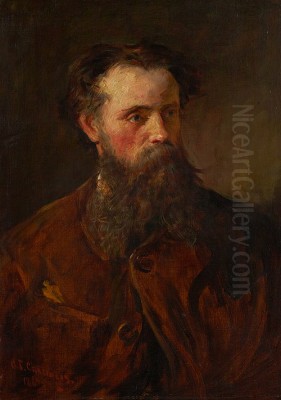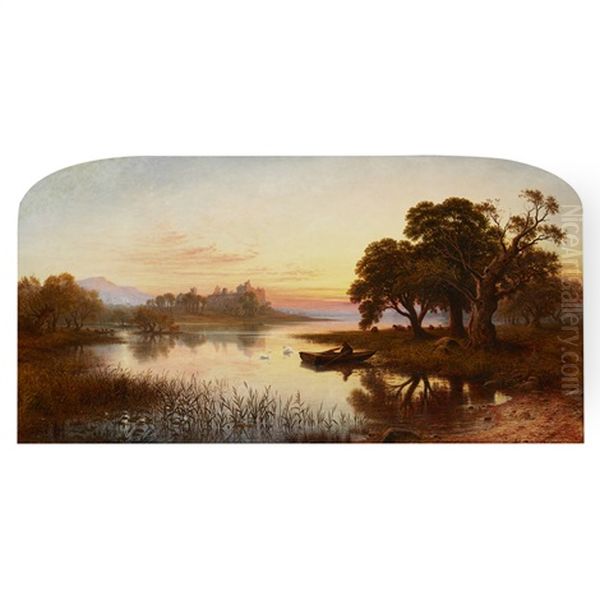
Waller Hugh Paton stands as a significant figure in the landscape of nineteenth-century Scottish art. Born in 1828 and passing away in 1895, he dedicated his career to capturing the natural beauty of his homeland, particularly its rugged highlands and serene lochs. He is celebrated not only for the meticulous detail and atmospheric sensitivity of his work but also for his pioneering approach to painting directly from nature, becoming arguably the first Scottish artist to complete entire oil paintings outdoors.
Early Life and Artistic Beginnings
Waller Hugh Paton was born into an artistic family in Wooers-Alley, Dunfermline, Fife. His father, Joseph Neil Paton senior, was a respected designer, particularly known for his work with damask. This creative environment undoubtedly shaped Waller and his elder brother, Joseph Noël Paton, who would himself achieve fame as a painter and sculptor, eventually receiving a knighthood and the title of Queen's Limner for Scotland. The elder Paton brother is often associated with historical, allegorical, and fairy subjects, sometimes linked to the Pre-Raphaelite circle.
Initially, Waller followed in his father's footsteps, training and working for a time as a designer. However, his passion lay elsewhere. The pull towards fine art proved strong, and he made the decision to pursue painting. A key moment in his early artistic development came in 1848 when he began studying watercolour techniques under the guidance of John Adam Houston (often cited as John R.A.S. Houston), a notable Scottish painter known for his historical scenes and landscapes. This instruction provided Paton with a solid foundation in handling paint and observing nature.
The Emergence of a Landscape Specialist
Paton quickly found his niche in landscape painting. From 1851 onwards, he became a regular exhibitor at the prestigious Royal Scottish Academy (RSA) in Edinburgh, showcasing his burgeoning talent and distinctive vision. His chosen subjects were overwhelmingly drawn from the Scottish countryside. He developed a particular fondness for the landscapes of Perthshire, Aberdeenshire, and, perhaps most significantly, the Isle of Arran.

The dramatic mountains, winding rivers, coastal scenery, and changing skies of these regions became the central motifs of his art. He was drawn to the specific qualities of light and atmosphere found in the Scottish environment, developing a particular reputation for his evocative depictions of sunsets and twilight scenes, where fading light cast long shadows and imbued the landscape with a sense of poetic melancholy or serene beauty.
His commitment to the RSA was recognized early on. He was elected an Associate (ARSA) in 1857, a significant step confirming his rising status within the Scottish art establishment. This was followed by his election as a full Academician (RSA) in 1865, cementing his position as one of Scotland's leading landscape painters of his generation.
Pioneering Painting 'En Plein Air'
One of Waller Hugh Paton's most distinctive contributions to Scottish art practice was his commitment to painting en plein air, or entirely outdoors. While many artists before him, such as John Constable in England, made outdoor sketches and studies, it was far less common, particularly in the challenging Scottish climate, to complete finished oil paintings directly in front of the subject. Paton is widely credited as being the first Scottish artist to fully embrace this method for his oil works.
This approach was fundamental to his artistic aims. By working directly from nature, he could capture the fleeting effects of light, shadow, and weather with a greater degree of immediacy and accuracy than was possible through studio work based on sketches and memory. It allowed him to observe the intricate details of foliage, rock formations, and water surfaces under specific lighting conditions, lending his canvases a remarkable sense of fidelity and presence. This dedication to outdoor work aligns him with the broader naturalist trends in European art of the period, including the Barbizon School painters in France like Jean-Baptiste-Camille Corot or Théodore Rousseau, although Paton developed his own distinctly Scottish interpretation.
Pre-Raphaelite Influences and Detailed Naturalism
Paton's meticulous attention to detail and his emphasis on truth to nature connect him strongly with the ideals of the Pre-Raphaelite Brotherhood (PRB), which had emerged in England around 1848. Led by figures such as John Everett Millais, William Holman Hunt, and Dante Gabriel Rossetti, the PRB advocated for a return to the perceived honesty and detailed intensity of early Renaissance art, rejecting the more formulaic conventions of academic painting.
The influential critic John Ruskin, a major champion of the Pre-Raphaelites and an advocate for close observation of the natural world, reportedly admired Paton's work. Paton's landscapes embody many Ruskinian and Pre-Raphaelite principles: sharp focus, bright, clear colours, and an almost scientific rendering of botanical and geological detail. Unlike the core PRB members, who often focused on literary, historical, or religious figure subjects, Paton applied these principles almost exclusively to landscape. His brother, Sir Joseph Noël Paton, engaged more directly with the narrative and symbolic aspects often associated with Pre-Raphaelitism.
Waller Hugh Paton's paintings often feature a high degree of finish, with every element rendered with painstaking care. This detailed approach, combined with his sensitivity to atmospheric effects, created landscapes that were both topographically accurate and emotionally resonant. His work can be seen as a Scottish parallel to the detailed landscape painting practiced by some English artists associated with or influenced by the PRB, such as Alfred William Hunt or perhaps the earlier work of John Brett.
Major Works and Signature Style
Throughout his career, Waller Hugh Paton produced a significant body of work, much of it focused on his beloved Scottish landscapes. Several paintings stand out as particularly representative of his style and achievements.
Lamlash Bay, Isle of Arran is one such work, often noted as having been painted during time spent on the island with his brother Joseph. It exemplifies his ability to capture the specific character of the Arran scenery, likely showcasing his skill in rendering coastal light and water. This painting is held within the collection of the Royal Scottish Academy, highlighting its significance.
Perhaps his most celebrated painting is Dreamthorp (1865). This large canvas depicts the town of Linlithgow, featuring its palace, St Michael's Kirk, and the loch, all bathed in the warm, low light of sunset. The painting is remarkable for its panoramic scope, intricate detail in both architecture and landscape, and the evocative rendering of the evening atmosphere. It is widely considered a high point of his career, demonstrating his mastery of composition, detail, and light.
In 1862, Paton received a prestigious commission directly from Queen Victoria to create a watercolour painting of the Palace of Holyroodhouse in Edinburgh. This royal patronage underscores the high regard in which his work was held at the time and his status as a leading artist.
Other notable works further illustrate his range and recurring themes, such as Kilmory Bay, Arran, Moonlight (1873), which shows his interest extended beyond sunsets to other challenging light conditions like moonlight, requiring careful observation of tonal values. Titles like Autumn Evening on the Arran reinforce his focus on specific times of day and seasons, capturing the unique moods associated with them. His dedication to these themes resulted in a cohesive and recognizable body of work.
Recognition, Context, and Comparisons
Paton's career was marked by consistent recognition within the Scottish art world. His elections to the RSA (ARSA in 1857, RSA in 1865) were significant milestones. Beyond the RSA and the royal commission, he also received honours such as being made an honorary member of the Society of Watercolour Painters in Liverpool. The popularity of his vision of Scotland is further evidenced by the fact that many of his works were reproduced as prints or postcards, making his imagery accessible to a wider public.
Placing Paton in the broader context of 19th-century British art reveals interesting connections and contrasts. His detailed naturalism links him to the Pre-Raphaelite movement, as discussed, alongside artists like Millais, Hunt, and Ruskin's favoured landscape painters. The comparison sometimes made to J.M.W. Turner is intriguing; while both artists were masters of light and atmosphere, Turner's approach was generally broader, more dramatic, and less focused on minute detail than Paton's meticulous style. Paton's work offers a calmer, more topographically precise vision.
Within Scotland, his contemporaries included landscape painters like Horatio McCulloch, known for his grand, romantic Highland scenes, and Sam Bough, noted for his vigorous, often breezy landscapes and coastal scenes. Paton's style offered a more detailed, perhaps quieter alternative. Later Scottish artists like William McTaggart would move towards a looser, more impressionistic handling of paint, representing a different direction in Scottish landscape painting. Paton's influence can perhaps be seen in the work of artists like Robert Herdman, who also painted Scottish landscapes with attention to detail. Compared to English contemporaries known for detailed landscapes like Benjamin Williams Leader or Myles Birket Foster (primarily watercolour), Paton brought a distinctly Scottish sensibility to his subjects. While perhaps not achieving the same level of widespread fame as some English counterparts like John Atkinson Grimshaw (known for his moonlit urban scenes) or the established academician William Dyce (another Scot prominent in London), Paton held a secure and respected position, particularly within Scotland.
Later Life and Lasting Legacy
Waller Hugh Paton continued to paint and exhibit throughout his later life, though sources suggest his health began to decline in his final years. He passed away in Edinburgh in 1895, leaving behind a substantial legacy as one of Scotland's foremost landscape painters of the Victorian era.
His primary contribution lies in his sensitive and highly detailed depictions of the Scottish landscape, particularly his pioneering commitment to completing finished oil paintings entirely en plein air. This practice allowed him to achieve a unique level of fidelity in capturing the specific light, atmosphere, and natural detail of his chosen scenes. His connection to Pre-Raphaelite ideals, filtered through the lens of landscape painting, resulted in a distinctive style that resonated with contemporary audiences and critics like Ruskin.
Today, Waller Hugh Paton's works are held in major public collections, including the National Galleries of Scotland and the Royal Scottish Academy. While perhaps less internationally renowned than his brother Sir Joseph Noël Paton or some other British artists of the period, his work remains highly esteemed within the context of Scottish art history. Academic study continues to explore his technique, his relationship with contemporaries, and his place within the broader movements of 19th-century naturalism and landscape painting. He remains a key figure for understanding the development of landscape art in Scotland, celebrated for his technical skill, his innovative methods, and his enduringly beautiful vision of his native land.